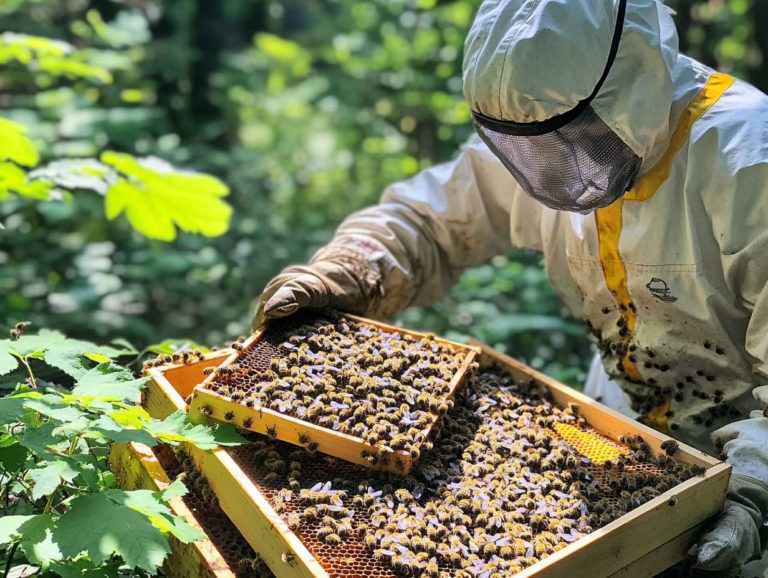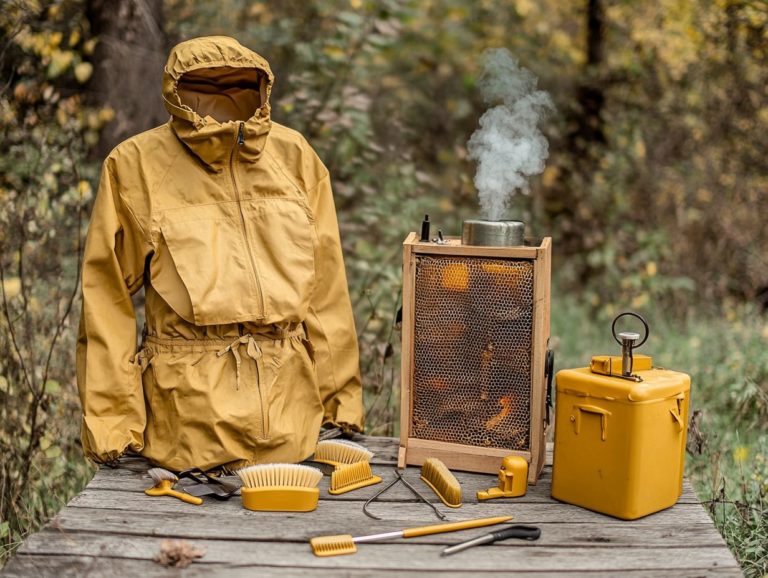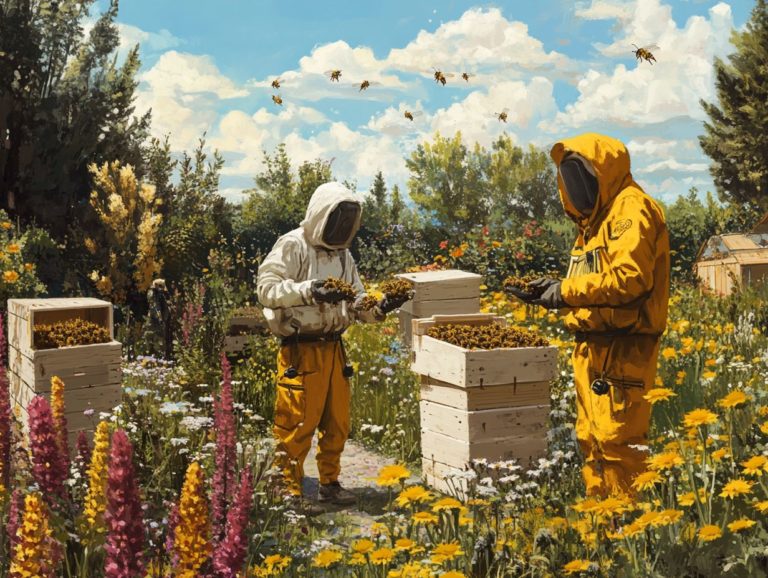Hive Management: When to Add Supers
Determining the right moment to add supers to your beehive is essential for effective hive management. This maximizes honey production and ensures the overall health of your bee colony.
You ll explore the key factors that influence timing, the ideal number of supers for various hive configurations, and the different types available. You will learn how to properly add supers to your hive, recognize the signs that indicate it s time to expand, such as swarm signs and high bee density, and understand the consequences of delaying this important step.
Whether you re a seasoned beekeeper or just stepping into the world of beekeeping, this guide will equip you with the knowledge you need to keep your hives thriving, even during periods of nectar dearth.
Contents
- Key Takeaways:
- When is the Best Time to Add Supers?
- How Many Supers Should be Added?
- What are the Different Types of Supers?
- How to Add Supers to a Hive?
- What are the Signs that Supers Need to be Added?
- 4. Honey Flow
- The Risks of Delaying Super Additions!
- 1. Swarm Prevention
- 2. Honey Production Decrease
- Frequently Asked Questions
- Curious about adding supers to your Langstroth hive?
- What is the purpose of adding Dadant Supers to a hive?
- How can I tell if my Langstroth hive needs supers?
- What happens if I don’t add supers to my Langstroth hive?
- Can I add supers to my Langstroth hive too early?
- How many supers should I add to my hive?
Key Takeaways:
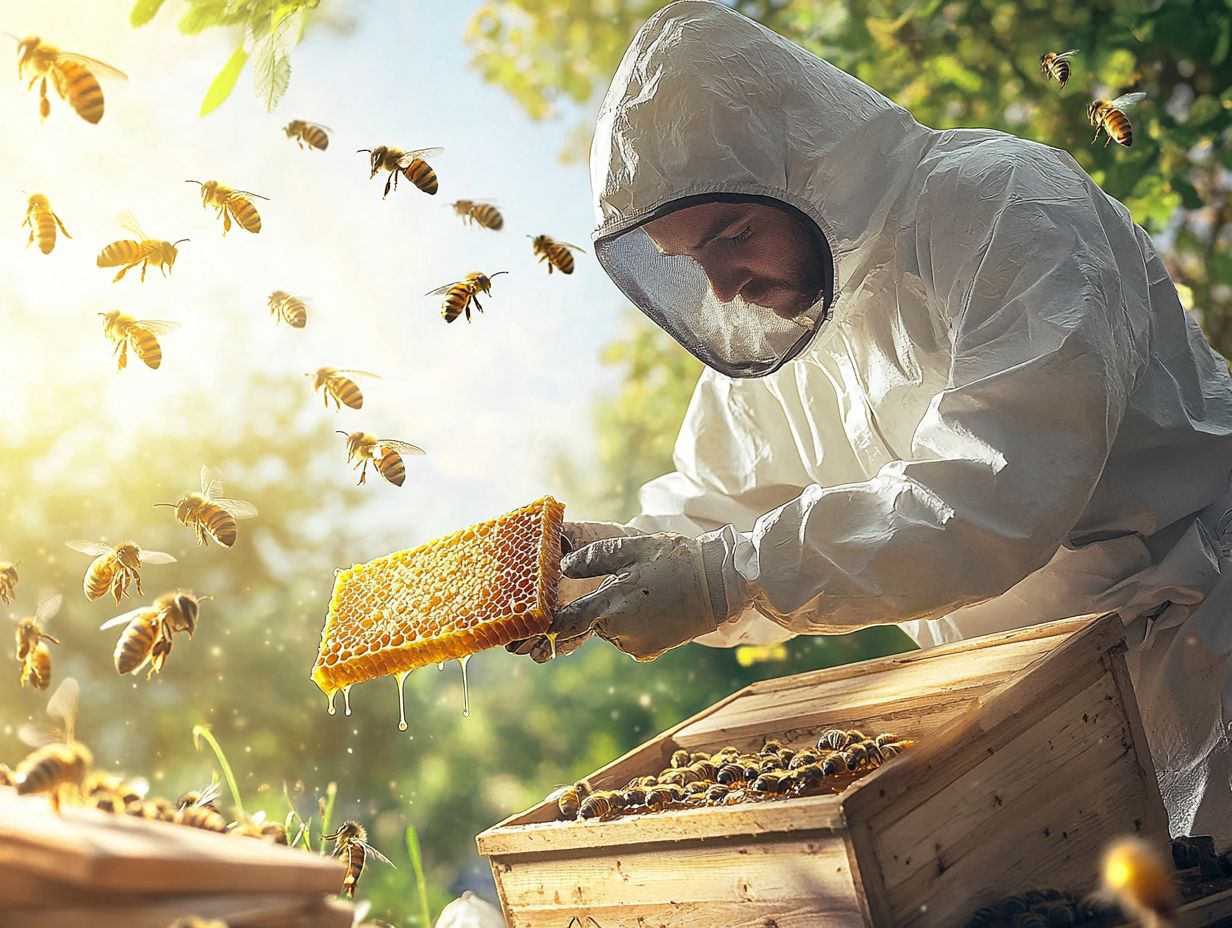
- The best time to add supers to a hive is when the colony is expanding and in need of more space.
- The ideal number of supers for a hive depends on factors such as bee population, honey production, available space, and the presence of queen cells.
- The three types of supers – shallow, medium, and deep – have different purposes and should be used accordingly in hive management.
When is the Best Time to Add Supers?
Timing is crucial in your beekeeping journey, especially when adding honey supers to your Langstroth hive. Consider factors like the availability of flowers, seasonal feeding practices, and the overall health of your bee colony, as these elements significantly influence the optimal moment for super addition. Proper Varroa management and observing the behavior of your bees are also essential for super addition.
Grasping these nuances is vital for maximizing your honey production while maintaining the vitality of your hive. If you re in Jackson County, Oregon, keep a close eye on local flora and climate patterns to ensure your bees have the resources and space they need to thrive.
Being attuned to the signs of swarming helps you prevent overcrowding and enhances your hive management.
What Factors Affect the Timing of Adding Supers, and How Can You Manage Varroa?
The timing of adding honey supers hinges on several key factors, including nectar flow, hive health, and the activity levels of your bees. By closely monitoring the brood area for signs that your queen bee is strong and healthy, you can better determine when your bee colony is primed for expansion. Ensuring proper mite treatments is also crucial for maintaining hive health and readiness for super addition.
When you notice an uptick in nectar flow, it signals plentiful foraging opportunities for your bees, encouraging them to gather and store more honey. This natural bounty is a clear indicator that it s time to consider adding extra supers to accommodate the increasing honey reserves, ensuring enough room for both nectar and pollen storage.
Additionally, assessing the overall health of your hive is vital. A thriving colony with energetic bee activity is a strong sign that it s ready for expansion. Pay attention to the brood area; an active and well-cared-for queen means your colony is flourishing and capable of supporting additional supers. Incorporating queen excluders can also help manage brood supers effectively.
By grasping these dynamics, you can enhance your hive management practices and ultimately boost your honey yield.
How Many Supers Should be Added?
Determining the optimal number of honey supers to add to your hive is essential for effective hive management and maximizing honey production. The size, health, and activity level of your bee colony are pivotal factors in making this decision. Effective Varroa management during this process ensures your colony remains healthy and robust.
As a beekeeper, consider elements like when your bees fill the space with comb and the growth stage of your colony. During periods of rapid growth, adding deep supers can be particularly advantageous, helping to prevent overcrowding and facilitating efficient nectar and pollen storage. Regular inspections for comb drawing can also help manage hive expansion effectively.
This thoughtful strategy ensures that your bees have the space they need to flourish and produce the honey you desire while maintaining proper hive vitality and health.
What is the Ideal Number of Supers for a Hive?
The ideal number of supers for your hive depends on the strength of your bee colony and your specific goals for honey production. A well-established colony may require multiple supers during peak nectar flow when bees collect the most nectar.
During these crucial times, the bees foraging activity ramps up significantly. Make sure there s plenty of space in the hive for all the nectar they are gathering. Act quickly to monitor your colony s strength. A robust population can handle more supers effectively, helping you prevent swarming and ensuring efficient honey bee nutrition.
Remember, weather conditions and local flower availability greatly impact when you should add supers. By recognizing these dynamics, you can optimize honey production and support your bee colony’s health, creating a thriving environment for your beekeeping endeavors. The Honey Bee Health Coalition offers valuable insights to help you succeed in beekeeping.
What are the Different Types of Supers?
In beekeeping, you will encounter various honey supers designed for use in a Langstroth hive. Each type enhances different aspects of honey production. Understanding the beehive structure is crucial for selecting the right super for your needs.
Shallow supers, medium supers, and deep supers serve distinct roles in honey storage, accessibility, and effective hive management. Selecting the right type of super is essential for promoting efficient honey extraction while safeguarding the health and vitality of your bee colony. Using Dadant Supers may also be beneficial depending on your specific hive setup.
1. Shallow Supers
Shallow supers are excellent for honey storage, thanks to their lightweight design that makes them easy to handle when filling frames. They are especially useful for beekeepers who may face physical limitations.
Shallow supers not only simplify the honey extraction process, but their reduced weight also eases strain on your body. This allows you to engage in beekeeping without discomfort, even if you have arthritis or back problems. This makes managing shallow supers easier, especially when feeding.
Beyond enhancing your comfort, these supers also promote more efficient honey production. You can fill and harvest them more frequently than deeper alternatives, fostering a more sustainable practice and allowing easier hive management throughout the year. Shallow supers also help draw comb better and improve frame filling.
2. Medium Supers
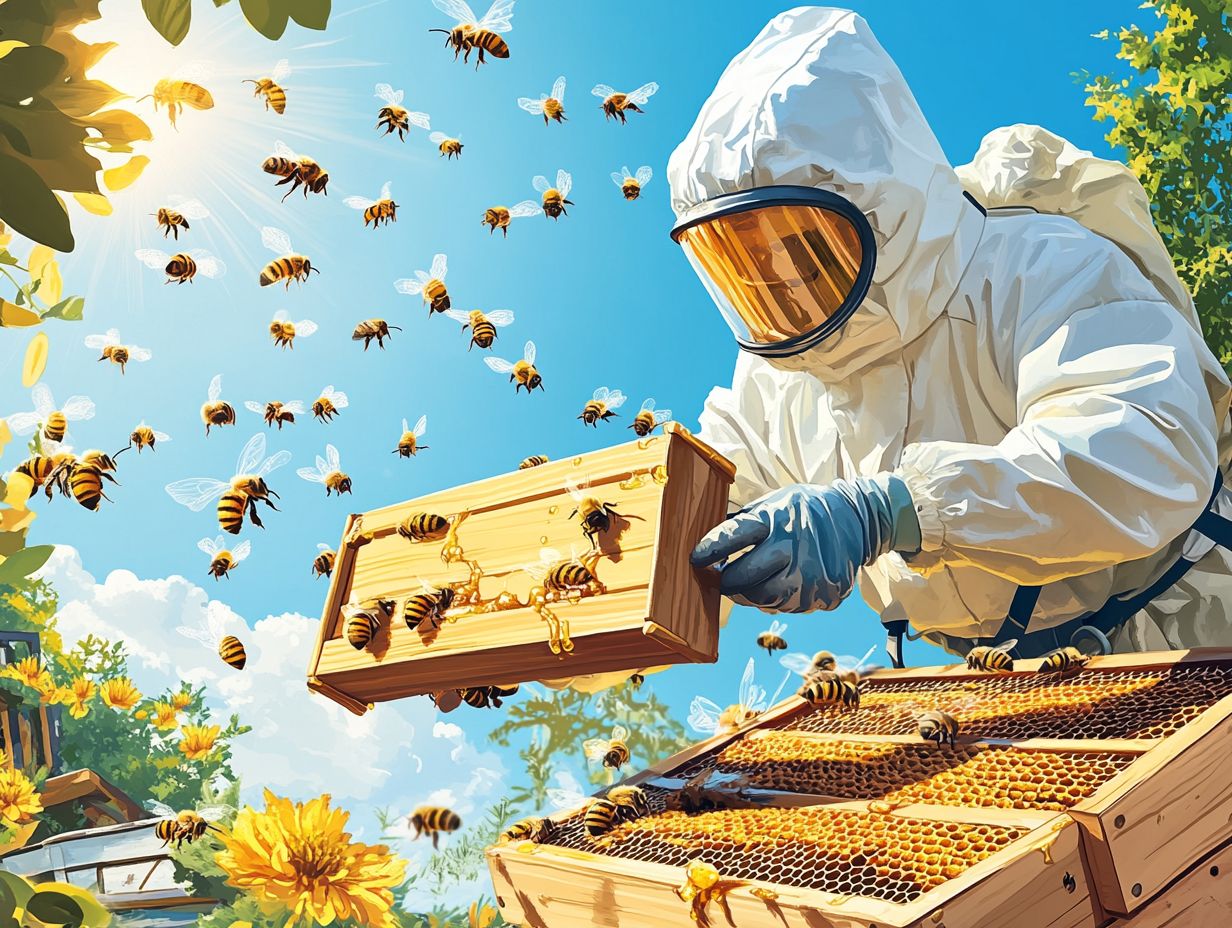
Medium supers offer a balanced solution, optimizing honey production without the cumbersome weight of deep supers. This makes them effective for managing bee activity with finesse.
Their versatility shines when adapting to various colony strengths, whether nurturing a growing population or supporting a well-established hive. With medium supers, you can effortlessly monitor changes in nectar flow, ensuring your bees have ample space to store honey while keeping the hive organized.
This management approach promotes healthier bee colonies and enhances overall production efficiency.
You ll find that medium supers are lighter and easier to handle, significantly reducing physical strain during maintenance. This ease of use allows for better access during hive inspections, leading to a more productive apiary.
3. Deep Supers
Deep supers are crafted to cater to the evolving needs of your growing bee colony, offering generous space for both honey storage and the expansion of the brood chamber. These deep hive bodies are a staple in effective hive management.
These specialized components are essential in hive management, particularly during times when populations surge due to favorable foraging conditions or seasonal peaks. Incorporating deep supers into your beekeeping practices allows you to manage the increased nectar collection, enabling your colonies to store more honey an absolute necessity for sustaining their growth. Ensure the hive body has enough space for brood and honey storage to maintain hive vitality.
Ensure there is enough room for the queen to lay her eggs, as it allows the brood area to expand and fosters the development of healthy offspring, which are vital for the hive’s longevity. Proper management of feeding ratios can support the hive during periods of scarcity.
Ultimately, deep supers streamline efficient honey production and bolster the overall vitality of your bee population, paving the way for a more sustainable approach to beekeeping. They are especially valuable during the months of August and September when hive activity is high.
How to Add Supers to a Hive?
When adding supers to a hive, approach the task with careful planning and execution to maintain hive health and effective management. Utilizing proper pest control measures during this process is also key to maintaining hive health.
Begin by preparing the hive, carefully observing the behavior of the worker bees, and assessing the brood area for any signs of overcrowding. Your attentive management during this process will be key in ensuring a seamless addition of supers, ultimately influencing honey production and the overall vitality of your bee colony. Ensure proper comb drawing and monitor for queen cells during this stage to enhance super addition.
1. Preparing the Hive
Preparing your hive before adding supers is crucial. Ensure optimal hive management, assess hive health, and monitor the activity of your worker bees. Managing Varroa mites and controlling pests is also important during this preparatory stage.
To kick off this important process, start with a comprehensive inspection of your existing hive setup. Check for adequate space within the hive, as overcrowding can lead to swarming a significant threat to the stability of your colony. Evaluate the availability of resources, such as stored honey and pollen, ensuring these essential components adequately support the growth and productivity of your colony. During this check, pay attention to the hive body and bee space for effective management.
It’s vital to assess the health of your queen bee and her brood; a robust and active queen is essential for maintaining a strong workforce. By keeping a close eye on the overall behavior and activities of your worker bees, you’ll gain valuable insights into their status and readiness for expansion, especially for effective Varroa management and ensuring Honey Bee Health Coalition guidelines are met.
2. Placing the Supers
For those using a Langstroth hive, proper placement of the supers is crucial for optimal results.
Placing the supers correctly is vital for maximizing the vitality of your hive and ensuring effective frame filling, which ultimately drives honey production. Using Dadant Supers or a deep hive body as needed can significantly influence your results.
Align the supers correctly so your bees can move around easily and access all frames with ease. When adding supers, ensure they re spaced appropriately to provide the bees with enough room to work without overcrowding. This promotes better air circulation and reduces the risk of swarming.
Keep a close eye on your colony’s growth patterns and adjust the placement of the supers accordingly. Add them when the lower boxes are at least 70% full. This strategic approach enhances your honey yield and helps maintain the overall health and productivity of your hive, especially during critical times like August and September. Act quickly to ensure your bees thrive during peak times!
3. Checking for Proper Placement
After you add the supers, it s essential to check their placement to ensure efficient hive management and optimal honey production. This step is crucial if you aim to boost your honey yield while maintaining the well-being of your worker bees.
Observing the behavior of the worker bees can provide valuable insights into how well they are adapting to the new supers. For instance, if you notice increased foraging activity, that s a great indication that the bees are settling into their expanded space. Additionally, look for signs of wax capping on the honeycomb within the new supers; this is a positive signal that your bees are effectively storing nectar.
It s also wise to periodically inspect the supers for any signs of overcrowding or stress within the hive. Recognizing these issues early can prevent potential setbacks in honey production and hive health.
What are the Signs that Supers Need to be Added?
When introducing a package of bees to your hive, it’s crucial to understand when and how to appropriately add supers to support their growth.
As a beekeeper, you must remain vigilant in recognizing the signs that suggest it s time to add a super. Timely intervention is essential for maintaining the health of your hive and optimizing honey production.
Watch for increased bee activity, an overcrowded brood chamber, and elevated honey production rates these are clear indicators that your colony is in need of additional space to accommodate their growth.
By closely monitoring these signs, you can proactively address any overcrowding issues, ensuring the continued vitality of your bee colony.
1. Increased Bee Activity
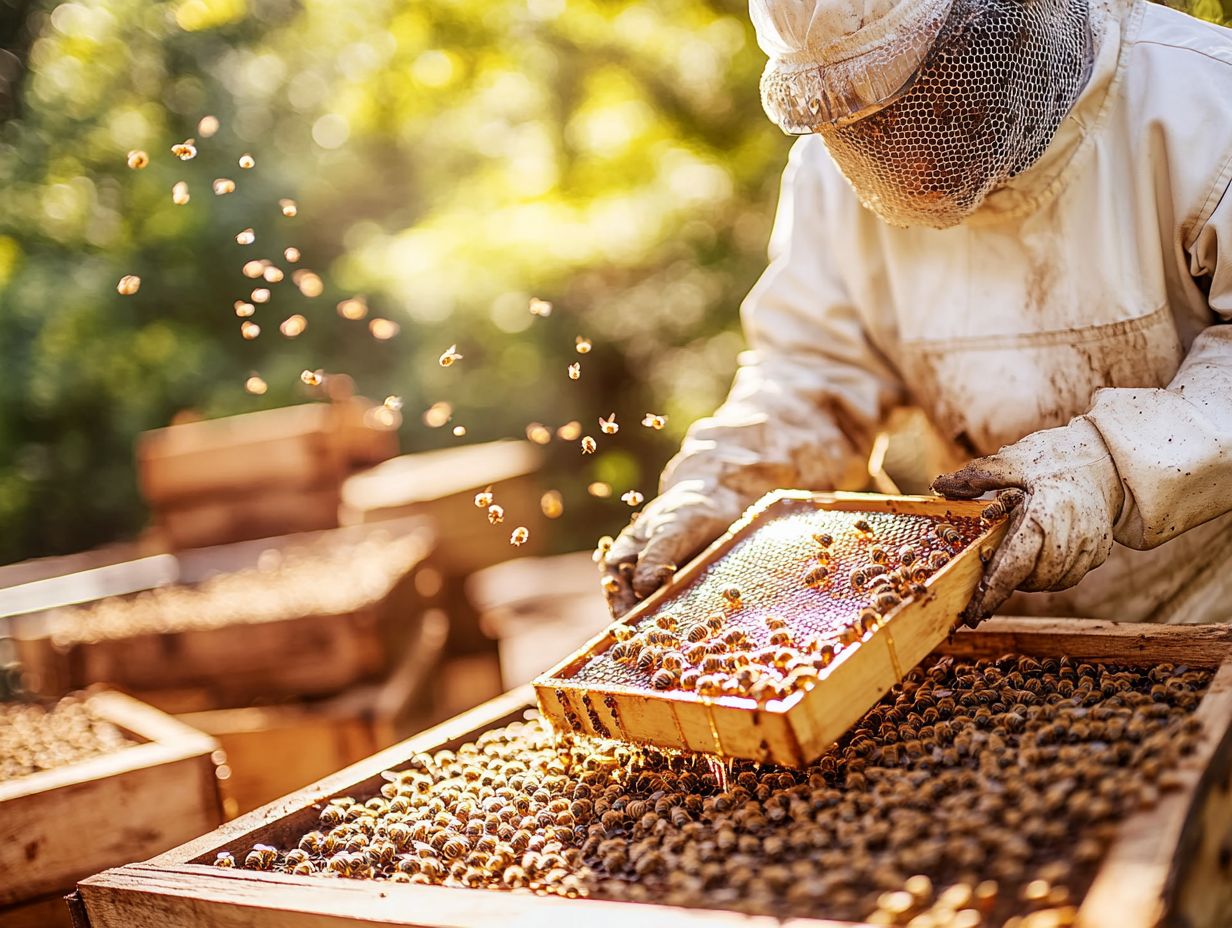
Increased bee activity is often a telling sign that it might be time for you to consider adding supers, as it indicates that your colony is thriving and in need of more space.
By monitoring the levels of activity among the worker bees, you can gain valuable insights into the health of your hive and its overall performance. When you notice a significant number of foragers leaving and returning with pollen and nectar, that’s your cue that you have a healthy colony on your hands that is actively expanding.
Paying attention to the bees’ behavior during temperature fluctuations and peak flowering times can help you uncover patterns that further indicate their growth potential. If you observe this heightened activity continuing, it s wise to evaluate the resources available in your hive and determine whether additional supers are necessary to prevent overcrowding and maintain optimal conditions for honey production.
2. Crowded Brood Chamber
A crowded brood chamber can be a clear indication that your hive is becoming overcrowded, prompting you to consider adding supers to create much-needed space.
When the living quarters for your bees grow cramped, you may notice a variety of stress-related behaviors, such as increased aggression or reduced productivity. This overcrowding can lead to a decline in the overall health of your colony, as it restricts the queen’s ability to lay eggs and stifles brood development.
It s crucial to recognize the early signs of overcrowding like bees clustering outside the entrance or an excess of stored honey to maintain hive harmony and productivity. By adding supers at the appropriate time, you can relieve congestion and encourage your colony to flourish, ultimately boosting honey production and refining your hive management strategies.
3. Honey Production
High levels of honey production can signal that your colony is primed for additional supers, especially during those peak nectar flow periods.
These moments are essential for you as a beekeeper, as the abundance of nectar directly influences your honey yields. By keeping a close eye on the activity levels and resource management within your hive, you can determine the optimal timing for adding supers. If you notice your bees actively foraging and diligently storing honey, it’s a strong indication that expanding the hive capacity could lead to a more bountiful harvest.
Therefore, grasping the nuances of nectar flow is not just about boosting honey production; it also plays a crucial role in sustaining the health and productivity of your entire colony. This is particularly essential for hives in regions like Jackson County Oregon where local nectar sources can vary.
4. Honey Flow
Understanding Varroa incidence during honey flow periods is essential for effective hive management.
Monitoring the honey flow is crucial for you as a beekeeper, as it directly impacts when and why you should add supers to your hive.
By grasping the dynamics of nectar flow, you can make informed decisions that enhance your hive’s productivity. Assessing the abundance of flowering plants and their nectar availability will guide you on when to add supers, ensuring that your bees have ample space to store the honey they diligently collect.
By observing hive activity and foraging patterns, you’ll identify the best moments to introduce additional supers. If you overcrowd the hive too soon, you risk triggering swarming behaviors. Delaying too long can lead to bees capping honey within existing frames, ultimately limiting your overall yield.
Thus, careful monitoring and timely intervention are vital for maximizing honey production during the peak nectar flow.
The Risks of Delaying Super Additions!
Neglecting to add supers when necessary can have adverse effects on your bee colony, leading to challenges such as swarm prevention issues and a decline in honey production.
Overcrowding may create a crowded space for baby bees, stressing the colony and disrupting their natural behaviors. Such conditions significantly impact the health and productivity of your entire hive, emphasizing the importance of timely intervention for any beekeeper.
1. Swarm Prevention
One of the primary reasons you should add supers promptly is to prevent swarming. Overcrowding can trigger this instinctual response from the bee colony.
When bees feel cramped, they prepare to divide the colony by creating a new queen and taking flight with part of the hive. This behavior can have significant consequences, affecting the colony s productivity, the local ecosystem, and other beekeepers.
By adding supers in a timely manner, you provide the necessary additional space, reducing the risk of congestion and ensuring that the bees have ample room to store honey and raise brood efficiently.
Implementing effective hive management techniques, such as regularly monitoring population levels, is crucial for maintaining the health of the colony and preventing unwanted swarming. Act quickly to supercharge your honey production!
2. Honey Production Decrease
When you neglect timely super addition, you risk a dip in honey production. Limited space constrains the colony’s ability to store excess nectar and pollen.
Failing to add supers at the right moment means your bees will struggle to optimize their foraging efforts. The flow of nectar plays a significant role in determining honey production; during peak blooming periods, the demand for storage space skyrockets. If your colonies can t expand their capacity to accommodate incoming nectar, they may become overcrowded.
This stress hampers the productivity of your bees and jeopardizes the overall health of the hive. By ensuring that you add supers promptly, you empower the bees to fully capitalize on the available nectar, ultimately enhancing your honey yields.
Utilizing guidance from the Dadant Family beekeeping methods can also provide significant benefits. Don t miss out check your hives today!
3. Brood Chamber Congestion
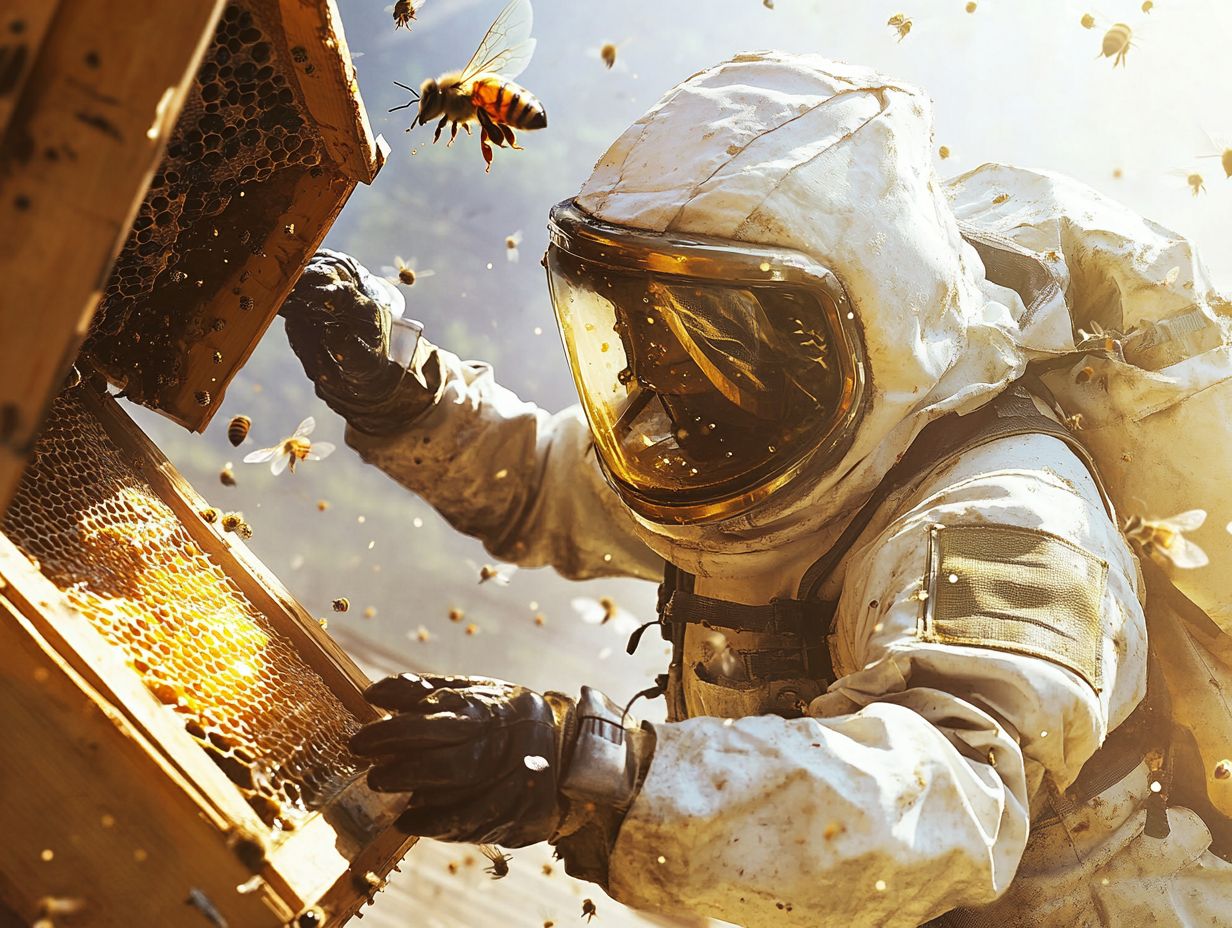
Congestion in the brood chamber can greatly impact the health of your bee colony. It restricts the queen’s ability to lay eggs and limits the workers’ capacity to care for the brood.
When space becomes cramped, your bees may struggle to communicate effectively and manage their resources. This leads to increased stress and greater vulnerability to disease.
Overcrowding can also cut into your honey production! When overwhelmed, workers become less efficient in their tasks. Preparing for periods of winter feed can help mitigate some of these challenges.
To address these issues, consider implementing strategies such as:
- Expanding the hive with additional honey supers
- Utilizing queen excluders (barriers that allow the queen to lay eggs in specific areas of the hive) to guide the queen’s egg-laying activities
Regular checks, including Varroa management, can help you identify and alleviate any bottlenecks. This ensures optimal airflow and access to necessary resources.
Act now to manage brood chamber congestion! Doing so will greatly boost the vitality of your hive.
Start monitoring your brood chamber today to ensure your bees thrive!
Frequently Asked Questions
Learn more about beekeeping practices with the Honey Bee Health Coalition and the Dadant Family.
Curious about adding supers to your Langstroth hive?
The best time to add supers to your hive is when the first box is almost completely full with bees and honey. This usually occurs in late spring or early summer, especially around August or September.
What is the purpose of adding Dadant Supers to a hive?
Adding supers to a hive, especially Dadant Supers, allows for more space for the bees to store honey. This helps prevent overcrowding and swarming.
How can I tell if my Langstroth hive needs supers?
You can tell if your hive needs supers by checking the top box to see if it is at least 80% full. Look for signs of overcrowding or congestion in the hive.
What happens if I don’t add supers to my Langstroth hive?
If you don’t add supers to your hive, the bees can become overcrowded and may end up swarming. This can also lead to a decrease in honey production.
Can I add supers to my Langstroth hive too early?
It’s not advisable to add supers too early, as this can cause the bees to neglect the brood chamber and focus solely on the supers. Wait until the first box is almost completely full before adding more supers, especially in regions like Jackson County, Oregon.
How many supers should I add to my hive?
The number of supers to add depends on the size and strength of your hive, as well as the local nectar flow. It’s recommended to start with one or two supers and add more if needed.

